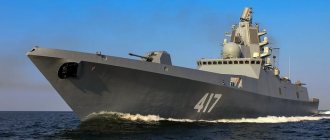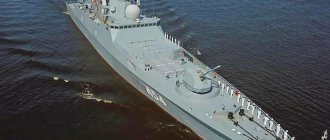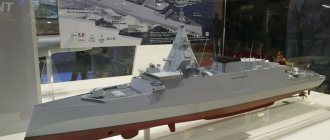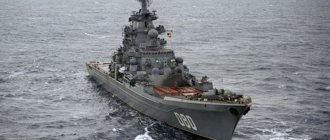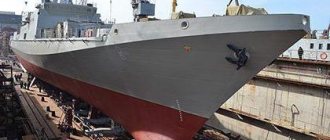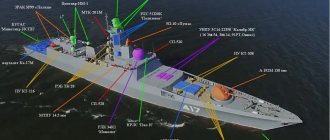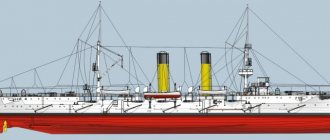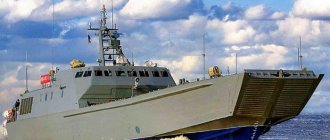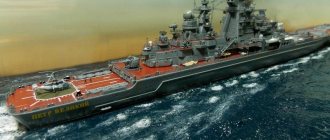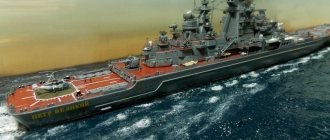Admiral of the Fleet of the Soviet Union Sergei Gorshkov during the Great Patriotic War commanded a brigade of cruisers, and subsequently served as Commander-in-Chief of the Navy for almost 30 years. It is not surprising that warships are named after him.
Previously, a heavy aircraft-carrying cruiser was named in honor of the admiral. Now the name of the naval commander has been assigned to a representative of the newest family - the multi-purpose frigate of Project 22350. These are not only completely new, modern ships, but also the first ones officially called frigates.
Origin of the name of the type and history of construction
The historical sailing frigate is a warship, fast and maneuverable, but not powerful enough to be used in the battle line. The name was first revived by the Royal Navy during the Second World War, giving it to light anti-submarine vessels.
In the American Navy after the war, air defense missile cruisers were called “frigates” for some time, but in 1975 the classification was changed. Thus, the modern frigate was finally defined as a small (in terms of displacement) air defense and anti-submarine defense ship.
In the Soviet Union, smaller vessels of this type were called “sentry”, and larger ones were called “large anti-submarine”. This classification was inherited by the Russian fleet. But in recent years, the term “frigate” has also begun to be used in Russia. And one of the first was “Admiral Gorshkov”.
For a long time, the basis of the Russian naval forces were ships designed and built during the Soviet era.
Moreover, the ships could be good in themselves - but the tasks facing the fleet have changed. What was needed was no longer “aircraft carrier killers” armed with heavy anti-ship missiles, but ships capable of effectively fighting piracy and supporting anti-terrorist operations.
Unfortunately, the difficult economic situation in the country did not always make it possible to even maintain existing combat units, let alone develop new ones. For example, the Yaroslav the Wise patrol ship was laid down back in 1988, but it entered service only 20 years later.
Only towards the end of the first decade of the 21st century did Russia again begin to build truly new and modern combat units for the Navy. The direct ancestors of the Admiral Gorshkov are patrol ships of Project 11540. These are ships developed and laid down in Soviet times. They refused to build the third ship in the series, even according to a modernized design, finding it did not fit into the fleet development plans.
The lead frigate of the basic project 22350 was laid down in 2006 in St. Petersburg. Four years later, the launch took place. In the future, according to the Commander-in-Chief of the Navy, such ships will become the main ones in the Russian ocean fleet. In the meantime, two frigates, Admiral Gorshkov and Admiral Kasatonov, are being tested. Two more ships of Project 22350, Admiral Golovko and Admiral Isakov, have not yet been launched.
Frigate "Admiral of the Fleet Kasatonov" project 22350
| Frigate "Admiral Kasatonov", Severomorsk | Frigate "Admiral of the Fleet Kasatonov" at sea | "Admiral of the Fleet Kasatonov" during the campaign |
| Frigate "Admiral of the Fleet Kasatonov", Barents Sea | "Admiral of the Fleet Kasatonov", signing ceremony | Frigate "Admiral Kasatonov", Severomorsk |
| Frigate "Admiral Kasatonov", Neva | The frigate "Admiral Kasatonov" entered trials | Frigate "Admiral of the Fleet Kasatonov" at sea |
| Frigate "Admiral of the Fleet Kasatonov" undergoing testing | "Admiral Kasatonov" returned to St. Petersburg | "Admiral of the Fleet Kasatonov" entered the ZHI |
| “Admiral of the Fleet Kasatonov”, preparation for ZHI | "Admiral of the Fleet Kasatonov" is ready for crew move-in | "Admiral of the Fleet Kasatonov" at the outfitting embankment |
| "Admiral of the Fleet Kasatonov" (tail number 431) | Frigate "Admiral of the Fleet Kasatonov", "Northern Shipyard" | "Admiral of the Fleet Kasatonov" at the outfitting pier |
| "Admiral of the Fleet Kasatonov" during construction | Frigate "Admiral Kasatonov", launching | Frigate "Admiral Kasatonov" before launching |
| "Admiral Kasatonov", launching ceremony | Godmother of the frigate "Admiral of the Fleet Kasatonov" | The frigate "Admiral of the Fleet Kasatonov" was removed from the boathouse |
- 1
- —>
The frigate “Admiral of the Fleet Kasatonov” is the first serial frigate of Project 22350, which is being built at Sudostroitelny (part of the United Shipbuilding Corporation). The lead frigate of this series is the Admiral of the Fleet of the Soviet Union Gorshkov.
By order of the Commander-in-Chief of the Navy, the first production ship was given the name “Admiral of the Fleet Kasatonov.” First Deputy Commander-in-Chief of the USSR Navy, Fleet Admiral Vladimir Afanasyevich Kasatonov, was the founder of an officer dynasty of three generations who devoted their lives to service in the Russian Navy.
Project 22350 (distant sea zone patrol ship/frigate) was developed by the Northern Design Bureau and approved by the command of the Russian Navy in June 2003 (date of approval of the preliminary design).
The frigates of this project are ships of a long forecastle design, with a solid superstructure. The frigate's physical fields are minimized. Thanks to the original architecture of the superstructure (stealth), the effective dispersion surface is reduced, which reduces the radar and optical signature of the ship.
Frigates are designed to conduct combat operations in oceanic and sea areas against enemy surface ships and submarines, repelling attacks by air attack weapons, both independently and as part of a formation of ships.
The frigates are armed with the A-192 130-mm caliber naval artillery mount, launchers for 16 Onyx or Kalibr-NKE anti-ship missiles, and the Poliment-Redut anti-aircraft missile system.
Main characteristics of the frigate "Admiral of the Fleet Kasatonov" (side number 431): Displacement 4500 tons. Length 135 meters, width 16 meters. Speed up to 29 knots. Cruising range 4500 miles. Autonomy 30 days. Crew 180-210 people.
Laid down at the Severnaya Verf Shipyard on November 26, 2009 (serial number 922). On October 30, 2014, the transfer from the boathouse to the launching dock took place at Severnaya Verf. Launched on December 12, 2014. Designed for the Black Sea Fleet of the Russian Navy. According to a message dated January 13, 2016, the main painting and insulation work on the frigate has been completed. According to a message dated March 29, the frigate began sewing up and equipping living quarters. According to a message dated June 23, the main work of the pre-construction period has been completed. According to a message dated June 05, 2022, the shipyard began testing diesel generators in the bow engine room of the frigate. According to a message dated November 8, a test launch of the propulsion engines of the main power plant was carried out. The crew's move-in is scheduled for mid-March 2022. On November 19, I carried out a control measurement of the magnetic field at the factory stand near the outfitting embankment. On December 21, it went to sea from the outfitting quay of the Severnaya Verf enterprise (St. Petersburg) to conduct the first stage of factory sea trials in the Baltic Sea testing grounds, which were completed on January 09, 2022. On April 21, 2022, I went to the Baltic waters for factory sea trials, which will last about one to one and a half months. According to a message dated May 15, it went to sea to undergo the next stage of factory sea trials. On May 29, after replenishing supplies in Baltiysk, it entered the next stage of factory sea trials, which are carried out at the training grounds of the Baltic Fleet. On November 20, she began the next stage of sea trials in the White Sea. According to a message dated December 8, it completed a series of tests in the White Sea and arrived at the main base of the Northern Fleet - Severomorsk. According to the message dated July 15, 2022, the signing of the acceptance certificate took place. On July 21, it became part of the Northern Fleet. The ceremony of raising the St. Andrew's flag and admission to the Russian Navy took place in St. Petersburg. According to a message dated September 14, he is heading to the main base of the Northern Fleet - Severomorsk, where he should arrive tomorrow. According to a message dated October 15, he entered the Barents Sea to check weapons and technical equipment.
On December 30, 2022, I went on a long hike. On January 11, 2022, he completed the passage through the Bay of Biscay and continued to follow the Atlantic Ocean in a southerly direction. According to a message dated February 3, it made a business call to the Greek port of Piraeus, which completed on February 5. According to a message dated February 18, he completed a three-day visit to the port of Alexandria, Egypt. On March 4, he completed a business call to the Turkish naval base Akzas-Karagach, located on the Mediterranean coast. On April 23 he returned to Severomorsk.
Brief description of the design
The frigate's hull has a long forecastle, and a double bottom extends from the bow to the engine room. In order to reduce the likelihood of the ship being detected by enemy radars, its superstructure is made of carbon fiber-based composites. Such materials absorb radio waves well.
In other words, “Admiral Gorshkov” was built using “stealth” technologies.
The frigate's power plant is of a combined type. In it, a diesel engine and a gas turbine operate on each of the propeller shafts. The power of turbines is 27,500 hp, and diesel power is 5,200 hp. The total power of the entire installation reaches 65,000 hp. The vessel uses fixed pitch propellers. The frigate is equipped with pitch stabilizers. Seaworthiness, ultimately, should allow the Admiral Gorshkov to conduct combat operations even in a force five storm.
The frigate's main artillery caliber is a universal 130mm automatic cannon in the A-192 mount. The previous gun mount of a similar caliber - the AK-130 - had a mass of over 80 tons. This limited its use only to large ships - cruisers and destroyers. The weight of the A-192 installation is only 25 tons, and it can be installed even on small ships such as frigates.
The rate of fire reaches 30 rounds per minute, the cannon can hit ground and sea targets at ranges of up to 23 kilometers. When using the gun as an anti-aircraft gun, the reach is 18 kilometers in altitude.
Small-caliber artillery is represented by two Broadsword anti-aircraft installations, one per side. Each installation carries two six-barrel automatic guns GSh 6-30KD, the rate of fire of which is up to 10 thousand rounds per minute (in total). "Broadswords" hit air targets at altitudes of up to 3 kilometers.
The Admiral Gorshkov's missile weapons are located in the nose of the hull in universal vertical launch systems.
Two UVP ZS14U1 contain eight cells each, into which missiles for various purposes can be loaded. The Onyx medium-range anti-ship missile allows you to hit ships at ranges of up to 300 kilometers, the mass of the warhead is 300 kilograms. It is invisible to radar and is used on a fire-and-forget basis.
Another option is Kalibr cruise missiles. This missile is universal and, depending on the version, can be anti-ship, anti-submarine or tactical for hitting ground targets. The flight range is up to 300 kilometers (like the Onyx), the warhead can be penetrating or high-explosive fragmentation. Guidance – inertial and radar. Anti-submarine missiles carry a torpedo as a warhead.
Finally, in the future the frigate will be able to use Zircon missiles, which have not yet entered service. These anti-ship missiles are distinguished by extremely high (hypersonic) flight speeds. Re-equipping Russian ships with these missiles could, according to some estimates, reduce the role of aircraft carriers and force the development of new missile defense systems.
The air defense of the Admiral Gorshkov is provided, in addition to artillery, by the Redut missile system. Its launchers are also in the nose, in front of the ZS14U1. The ammunition capacity includes up to 32 long-range 9M96 missiles (launch range - up to 120 km) and up to 128 close-range missiles 9M100 (range - about 15 km).
The frigate is protected from enemy submarines by two quadruple “Packet-NK” installations.
They hit submarines with small-sized 324 mm torpedoes, and attacking torpedoes with M-15 rocket-propelled anti-torpedoes. The deck hangar of the Admiral Gorshkov accommodates the Ka-27 helicopter, traditional for the Russian fleet.
Performance characteristics
For obvious reasons, most of these characteristics are unknown to the general public, and should not be known. However, many people are familiar with some general characteristics of the ships under construction from the new series:
- The hull is equipped with side stabilizers, the rudders of which will not be retracted. This device is necessary to ensure that the ship does not lose its performance during a storm;
- The superstructures will be made of special materials with composite characteristics. Such materials help reduce the radio-acoustic background of ships;
- The frigates will be equipped with Stealth technology. This technology makes ships stealthy, preventing enemy radars from detecting them;
- All will have a double bottom, which will help the ships stay afloat if damage occurs;
- A universal fire extinguishing system will be installed;
- The power of the propulsion system will reach 55 thousand horsepower;
- The maximum speed will reach 29 knots;
- Using economic propulsion (14 knots), the frigate will be able to travel 4,000 miles without stopping.
Most likely, when testing new ships, some of their initial characteristics will change.
Combat characteristics of Project 22350 frigates
It is noteworthy that there have also been changes in the composition of the US Navy. The main striking force is still heavy aircraft carriers, but the old frigates "Oliver Perry" have been replaced by "littoral" patrol ships of the "Freedom" and "Independence" projects. As another competitor of the "Gorshkov" we will consider the not new, but widespread German frigate of the MEKO family.
| Project 22350 | Littoral Combat Ship | MEKO 200 | |
| Displacement, tons | 5400 | 3100 | 3400 |
| Length, meters | 135 | 127 | 118 |
| Width, meters | 16 | 32 | 14,8 |
| Travel speed, knots | 30 | 44 | 32 |
| Artillery weapons | 1 x 130mm | 1 x 57mm, 2 x 30mm | 1 x 127mm |
| Missile weapons | 16 missile launchers "Onyx" and "Caliber" | 24 Hellfire missiles | 8 Harpoon missiles |
| Anti-aircraft weapons | 2 x ZAK "Broadsword", 4 x SAM "Redut" | 1 x ZRKSeaRAM | SAM SeaSparrow, ZAK Phalanx |
| Anti-submarine weapons | PLR 91Р2, 2 torpedo tubes | — | 2 Mk32 torpedo tubes |
| Aviation weapons | Ka-27 helicopter | Helicopter MH-60, UAV MQ-8 | Helicopter S-70 |
| Crew, man | 210 | 75 | 220 |
Comparing the tactical and technical characteristics, we can come to the conclusion: “Gorshkov,” if not a “superfrigate,” is not at all inferior in combat capabilities to its analogues. And it is quite capable of becoming a worthy competitor to German frigates if the ships of the project are exported.
But the characteristics of the newest American patrol boat make us think about the relevance of the comparison. The “littoral warship” departed too much from the established frigate concept. The caliber of the artillery gun is half as large, the anti-aircraft weapons are weaker, and the anti-submarine weapons are limited to the airborne helicopter. And the Hellfire light missiles are not at all a competitor to the Onyx anti-ship missiles.
If in their place there were at least Harpoon missiles, this would bring the possibilities closer together. Perhaps additional combat modules can significantly change the combat qualities of the LCS. The high speed and small crew size of the “Americans” deserve attention.
Armament of Project 22350 ships
The new ships are planned to be equipped with the most modern weapons:
- The most powerful armament of the frigates is expected to be the 16 Moskit anti-ship missile launcher;
- In addition, the vessels will be equipped with the A-192 universal automatic artillery mount;
- To destroy enemy submarines, the ships will be armed with Medvedka-2 anti-submarine systems;
- To assess the hydroacoustic underwater space, frigates are equipped with a special Vignette-M system. This system allows you to hear an enemy submarine at a distance of up to 60 kilometers;
- To protect themselves from air attack, they will use the Redut anti-aircraft missile system;
- For the same purpose, as well as for hitting unobtrusive targets on the surface of the water, they will be equipped with the Broadsword missile and gun system;
- All ships of this project must also have Ka-27 helicopters with the ability to take off and land on deck.
Again, it is quite obvious that in the future the ships’ armament can be supplemented or changed.
Prospects, combat and service
The main thing you can expect from Admiral Gorshkov is trouble-free operation. Still, this is the first in a series that has no continuity with its predecessors. So, first of all, one must hope that he will not develop any serious “childhood diseases.” And that the main diesel engine, which managed to break down, will remain the biggest problem.
The frigate will most likely carry out patrol duty. Perhaps it will support the actions of ground troops with missile strikes (if they are not withdrawn from hot spots in the coming years).
And if Project 22350 ships are built in a large series, then they have every chance of becoming the main “workhorse” of the fleet (as the American destroyer Arleigh Burke is today). And frigates armed with Zircon missiles will have the opportunity to attack any, even the largest, enemy ships. And heavy cruisers will no longer be needed to destroy aircraft carriers.
Project 22350 frigates have opened a new, long-awaited page in the history of the Russian fleet.
Even the best Soviet-built ships have long been in need of replacement - and now it has come. The Navy began to accept new ships, created taking into account modern requirements.
The activities of Admiral Sergei Gorshkov as Commander-in-Chief are currently assessed differently. There is an opinion that instead of building nuclear cruisers, the Soviet Union should have paid more attention to aircraft carriers. But there is a certain symbolism in the fact that the name of the admiral was assigned to a small ship, but powerfully armed and quite capable (in the future) of coping with the role of a counterweight to aircraft carriers.
